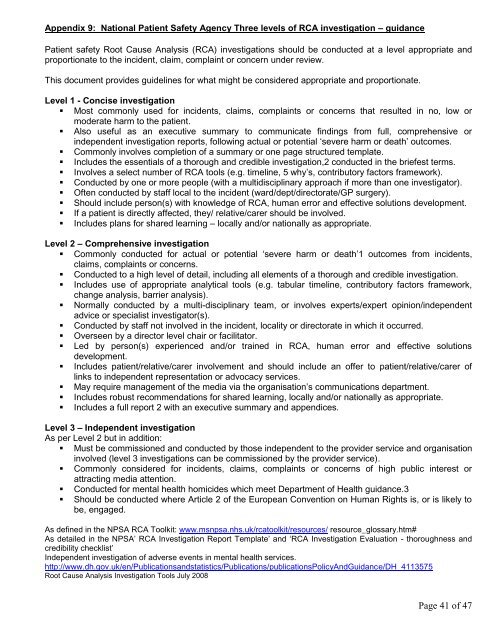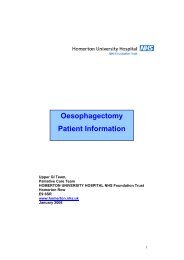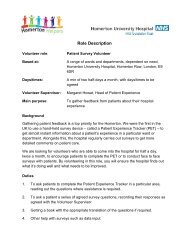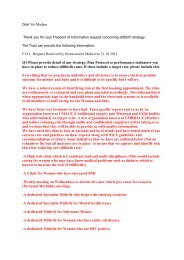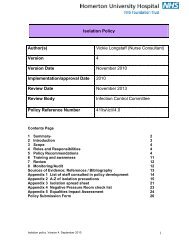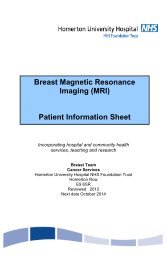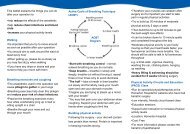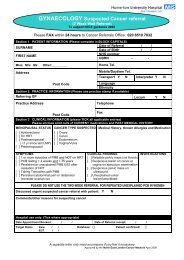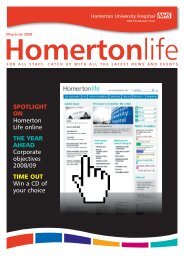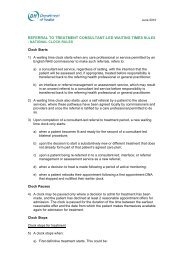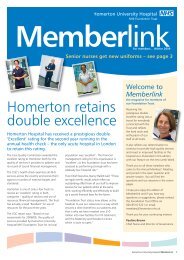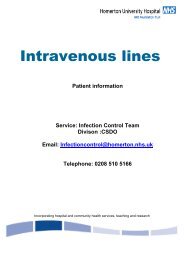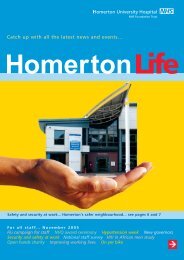Incident reporting policy - Homerton University Hospital
Incident reporting policy - Homerton University Hospital
Incident reporting policy - Homerton University Hospital
You also want an ePaper? Increase the reach of your titles
YUMPU automatically turns print PDFs into web optimized ePapers that Google loves.
Appendix 9: National Patient Safety Agency Three levels of RCA investigation – guidancePatient safety Root Cause Analysis (RCA) investigations should be conducted at a level appropriate andproportionate to the incident, claim, complaint or concern under review.This document provides guidelines for what might be considered appropriate and proportionate.Level 1 - Concise investigation• Most commonly used for incidents, claims, complaints or concerns that resulted in no, low ormoderate harm to the patient.• Also useful as an executive summary to communicate findings from full, comprehensive orindependent investigation reports, following actual or potential „severe harm or death‟ outcomes.• Commonly involves completion of a summary or one page structured template.• Includes the essentials of a thorough and credible investigation,2 conducted in the briefest terms.• Involves a select number of RCA tools (e.g. timeline, 5 why‟s, contributory factors framework).• Conducted by one or more people (with a multidisciplinary approach if more than one investigator).• Often conducted by staff local to the incident (ward/dept/directorate/GP surgery).• Should include person(s) with knowledge of RCA, human error and effective solutions development.• If a patient is directly affected, they/ relative/carer should be involved.• Includes plans for shared learning – locally and/or nationally as appropriate.Level 2 – Comprehensive investigation• Commonly conducted for actual or potential „severe harm or death‟1 outcomes from incidents,claims, complaints or concerns.• Conducted to a high level of detail, including all elements of a thorough and credible investigation.• Includes use of appropriate analytical tools (e.g. tabular timeline, contributory factors framework,change analysis, barrier analysis).• Normally conducted by a multi-disciplinary team, or involves experts/expert opinion/independentadvice or specialist investigator(s).• Conducted by staff not involved in the incident, locality or directorate in which it occurred.• Overseen by a director level chair or facilitator.• Led by person(s) experienced and/or trained in RCA, human error and effective solutionsdevelopment.• Includes patient/relative/carer involvement and should include an offer to patient/relative/carer oflinks to independent representation or advocacy services.• May require management of the media via the organisation‟s communications department.• Includes robust recommendations for shared learning, locally and/or nationally as appropriate.• Includes a full report 2 with an executive summary and appendices.Level 3 – Independent investigationAs per Level 2 but in addition:• Must be commissioned and conducted by those independent to the provider service and organisationinvolved (level 3 investigations can be commissioned by the provider service).• Commonly considered for incidents, claims, complaints or concerns of high public interest orattracting media attention.• Conducted for mental health homicides which meet Department of Health guidance.3• Should be conducted where Article 2 of the European Convention on Human Rights is, or is likely tobe, engaged.As defined in the NPSA RCA Toolkit: www.msnpsa.nhs.uk/rcatoolkit/resources/ resource_glossary.htm#As detailed in the NPSA‟ RCA Investigation Report Template‟ and „RCA Investigation Evaluation - thoroughness andcredibility checklist‟Independent investigation of adverse events in mental health services.http://www.dh.gov.uk/en/Publicationsandstatistics/Publications/publicationsPolicyAndGuidance/DH_4113575Root Cause Analysis Investigation Tools July 2008Page 41 of 47


